Academy's 1/48 scale
Lockheed P-38E Lightning
by Francesco Del Greco
|
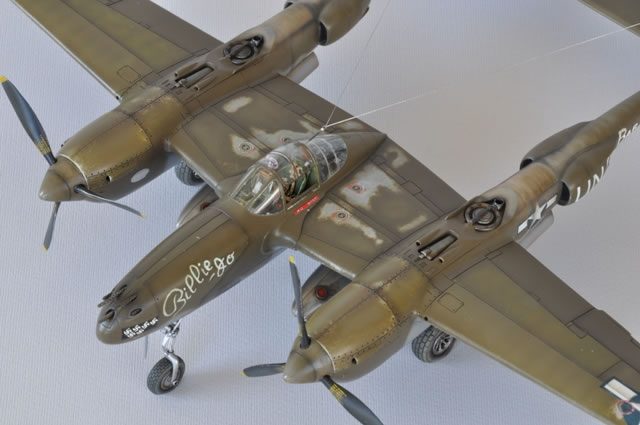
|
Lockheed P-38E Lightning |

Academy's 1/48 scale P-38E Lightning is available online from Squadron.com
The Ghost P-38
The Lockheed P-38 was cutting edge in aircraft engineering at the time of its design. Its outstanding performances were product of complex aircraft systems and tight building tolerances which came with a price in terms of field maintenance issues some of which were never really overcome despite a sheer amount of design improvements introduced during the years the aircraft was produced.
The particular P-38 I built is a special thing for me since the wreck of this very aircraft lies in the Adriatic sea not far from the beach of my hometown, Francavilla al Mare in Italy. It was ditched there on 20th April 1944 after suffering flak damage; the pilot, Lt. Cyril Nolen was taken prisoner by German troops and survived the war. I remember seeing the wreck the first time at the end of the 70’s when I was about 7 and I also remember how scary the wreck looked to me: it was a huge dark shape under the boat, resting on the bottom of the sea under a few meters of water and was covered with seaweeds and bits of fishing nets slowly moved by the stream. There was enough to fancy about a ghost plane with a ghost pilot still in the cockpit.
As with any ghost story, this too was scary yet attractive and I got hooked by the wreck so when I grew up I paid more visits to the site only to see it disappearing under the sand year after year.
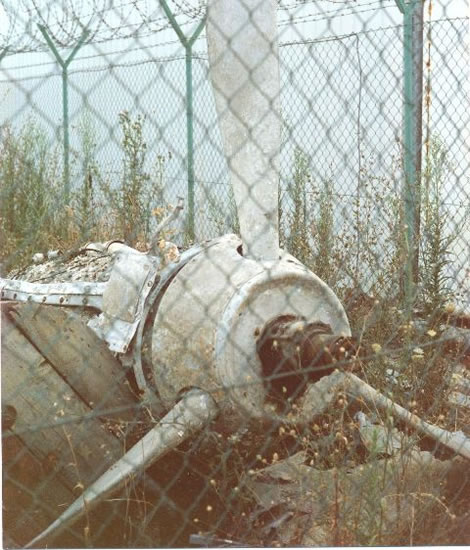
Sadly, as of today the wreck is totally buried in sand though from time to time the windscreen arch becomes visible; on an even more sad note the wreck have been systematically depredated by souvenir hunters especially of the most significant cockpit components but this is little thing compared to the damage made by a salvage company that attempted to recover the plane very likely to sell as scrap metal: the result was that the wreck was ignominiously broken and the salvage team probably managed to fish just the twin tails and part of the left wing which are no longer there. Finally one engine with propeller, the one that was knocked-off by the flak, was recovered and spent some years in open air storage before being cleaned and put on a plinth on the beach in front of the wreck site as a monument to fallen airmen.
My interest on the plane was fired again when the plate with the engine allowed to identify the aircraft on which it was assembled as P-38G-10 with serial number 42-10348 belonging to 94th FS of 1st FG of the USAAF operating out of Salsola (Foggia).
I had to model it!
The starting point is the Academy kit of the P-38E in 1:48 scale.
Construction started with the cockpit: I added just a few visible details in the tub since the plan was to close the canopy access hatch and leave the two side panels lowered to allow vision of the interior while preserving the aircraft lines. Some wiring was added to the radio boxes, along with the throttle and mixture levers and other details here and there; I also added a detailed seat with belts as this would have been the most visible item in the cockpit. Finally I built the instrument panel from sheet styrene and sandwiched the kit instruments decal to show dials behind the gauge holes.
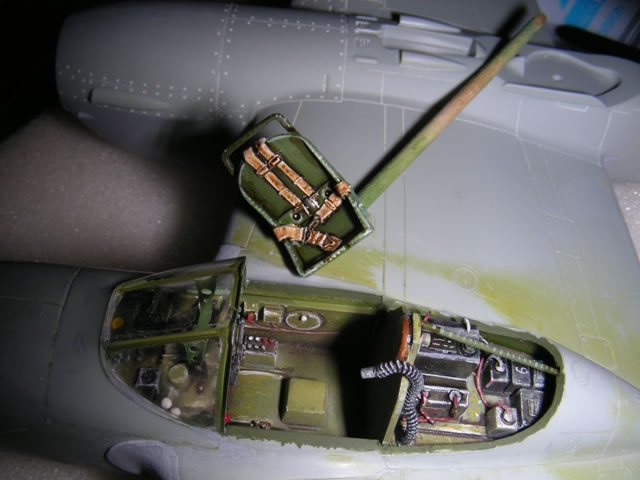
Airframe details were enhanced and this mainly involved hollowing the solid air scoops and improving the look and shape of the radiator housings at each side of the twin booms: the leading edges of the radiator housings were refined, the cooling flaps were replaced with finer elements in thin aluminum from a beer can and radiator faces and inner walls were made with plastic sheet and mesh. This completed and before proceeding in the build I checked the fit of the main components: everything was more or less OK with a few gaps and steps showing at various joints and needing to be fixed.
What was really NOT OK was the angle of the vertical fins which was far away from 90 degrees from horizontal plan: what to do? I elected to go for surgery and chop the tails away to reposition them at the right angle. The thickness of the plastic parts helped a lot, allowing strong sanding without risk of reaching critical thinness. Attention was put in restoring the same length to each of the twin tails and get a smooth joint between the booms and the tail ends; metal pins were used for strength. Despite a lot of measuring and attention put in the rebuild of the tail an issue materialized in the form of 4 millimeters and more missing in the horizontal plane span. Razor saw was at work again: I cut the horizontal plane in the middle and inserted plastic shims to integrate the missing span and metal pins for strength.
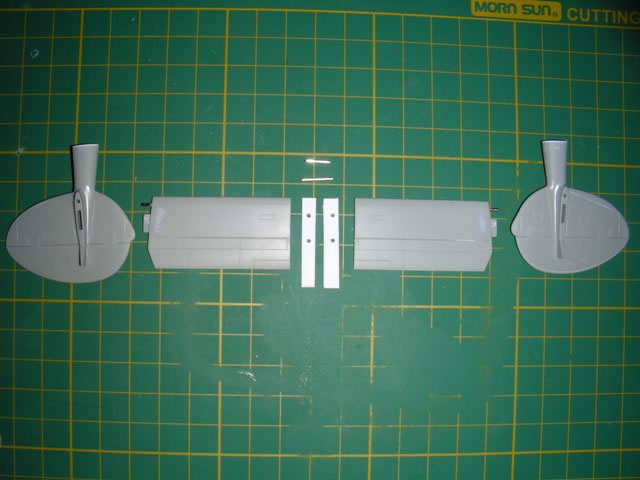
You figure my surprise when I checked the span of the modified part against quotes from a Lockheed drawing in my references and found 100% scale match!
Since the beginning, I wanted to incorporate some of the most distinctive features of the actual P-38 aircraft into this model. One which I believe is the most overlooked is representation of the oval mirror panels at the inner side of each engine nacelle: these were actually unpainted and highly polished areas of the aircraft aluminum skin used by the pilot to check that the nose gear leg and wheel were in the right position prior to landing the aircraft. Instead than using adhesive foil I went for a more realistic solution. I carved rectangular recesses in the kit plastic where I inserted sections of aluminum sheet from the beer can in a way they sat flush with the surrounding plastic surface. Then filled any gap with superglue, sanded and polished to high shine; two oval masks were cut from Tamiya tape and tacked in place to protect the mirrors from further treatments. The beer can came handy again to rebuild finer renditions of the oil cooler flaps under the engine nacelles. Another distinctive feature and a tough one to replicate was the ribbing in the aft portion of the canopy glazing. Early P-38’s aft canopy sections were frameless and provided with two clear Perspex formers assembled to the inner surface; I managed to examine a fragment of the canopy recovered from the wreck complete with a section of the former so I had a good idea of what the real thing looked like. I thought about painting thin parallel stripes with clear matt but this could have been difficult yet ineffective so I decided to replicate instead than imitate. I built a template for the formers from thick card and stretched clear sprue to the appropriate scale section. Then placed the stretched sprue over the template and formed it to shape using heat from an hairdryer. I fixed the two arches I made inside the canopy with a drop of superglue at the base of the canopy. The assembly was then dipped in Future which acted as bonding agent between the canopy and the formers. Finally I improved the look of the area underneath the windscreen which was quite busy in reality. I found from my references that P-38 cockpits were provided with a canvas cover acting as glare shield for the instrument panel which was often removed showing the many details beneath it. I eliminated the relevant section of plastic from the kit windshield base and added the defogging pipe, gunsight support bracing and the massive armored glass and associated supporting strut with which early Lightning variants were equipped.
The last airframe components were put together and considerable ballast stored in the nose to prevent tail sitting.
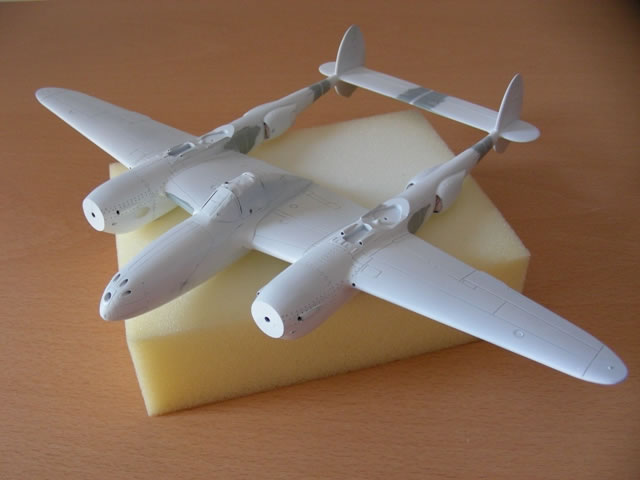
I primed the model with Tamiya fine (white) primer directly from the rattle can, made the needed adjustments and painting could begin.
While checking pictures of P-38s operating in Italy I noticed these worn machines, all veterans from the campaign in North Africa, had large areas of exposed airframe aluminum between cockpit and engine pods. The effect did not looked as chipping but more like a washout of the paint coating; this was likely to be due to blistering North African and Italian sun in conjunction with dust blown by the props. Therefore I coated selected areas of the model with Alclad aluminum so to be able to rub through the olive drab and uncover the metal underneath exactly as on the real airframe.
I started painting from the underside with an overall coat of neutral grey, then masked selected panels and painted them with different shades of the base color; after that a further variation was applied on the outer wing panels to suggest an idea of stressed metal in this area. In this process paint to thinner ratio was kept between 1 to 5 to 1 to 9; paints of choice were acrylics from Gunze and Tamiya range. Separation line between the neutral grey and the olive drab was defined with rolls of Patafix, an adhesive paste. The olive drab received the same panel treatment described for the neutral grey; when finished I re-contoured the separation line between the upper and lower colors with airbrush freehand to achieve a softer demarcation line. Again the paint was highly thinned in order to just leave a subtle shadow at each pass with the final effect being the result of a few transparent and overlapped layers. National and service markings were next and they were all painted with aid of masks made from Tamiya tape; despite a few mishaps it was unexpectedly easy and rewarding. Since no decals exists for this plane I brush painted all the specific markings, only the small writing “Nasa Serbska Sloboda” was made by scraping the paint to reveal the white primer underneath. I decided to place the “Bar Fly” name only on the left side since no pictures of the right side seem to exist; I found few images of 94th FS P-38s with names on the tails but photos were taken only of the left side so it could have been common practice to paint names only on the left tail boom. Finally from the very few existing pictures of the plane I was modeling I noticed that the serial number on the left tail was brush painted on the fixed portion of the vertical fin with no traces of it on the rudder. There is no picture of the other side but I also noticed that the visible inner portion of the right rudder had a different camouflage pattern than the one on the left. I then assumed that at some point in time the left rudder was replaced and the maintenance crew painted over the partial serial left on the vertical tail plane and replaced with a full brush painted serial number before the spare rudder was assembled. I also guessed that the original serial number had to be retained on the right tail and I replicated it with a stencil mask made from strips of Tamiya tape.
Weathering was completed with a panel wash with oils which was complemented by accentuating the shading of panel lines: each line was masked on the foremost or upper area and profiled with highly thinned dark grey leaving also some streaks going from front to tail and from top to bottom. Last were the peculiar P-38 heavy exhausts staining which were airbrushed with different shades of buff, sand and hearth color, dark gray was used to simulate coolant staining: early P-38 variants were plagued by leakage from intercoolers, the issue was fixed only on J and later models.
These can make a model shine or spoil it so I tried not to rush things.
I extended the oleo of the nose gear leg to depict the characteristic nose-up attitude seen in many pictures of parked P-38’s. The oleo section was eliminated from kit part and replaced with a longer section of brass tubing; scissor link was rebuilt along with some of the steering device details. I also reinforced the main gear legs with steel pins and to simulate the hydraulic brake lines I used a section of wiring from the actual aircraft wreck.
The wheels are a concession to aftermarket on this model: they are True Details items and the right tread pattern could be defined since the wheels of the wreck are exposed and they were pictured the last time the wreck re-emerged from the sand sea-bed. The antenna mast under the nose was built from styrene strip sanded to airfoil section.
The barrels of the .50 calibers came from Quickboost while the 20 mm gun was built from sections of brass tubing.
I made the ID and landing lights from aluminum foil formed with a rounded punch to get the mirrors; these were then placed inside their vanes and drops of tinted Future floor wax used to represent the glass.
The drop tanks are heavily modified kit stock; they were measured against those of the Hasegawa kit and considerably reduced in size and corrected in shape. I
also added the raised seam along them from stretched sprue and the fuel filler caps which were made with a ring of copper wire smashed flat with hammer. Finally I added some dents replicating shape and position of those visible in the pictures of the real aircraft. The tanks were weathered to represent fuel leaks and dust accumulation especially on their bellies.
To decide which color the prop spinners had to be I examined pictures I took of the engine with spinner and prop still attached shortly after it was recovered. Choices were among red, which was the color used for ID of Allied aircraft in the MTO, yellow, which some sources report for 94th FS P-38, and olive drab which few color pictures of early P-38 in Italy show that was sometime retained since the campaign in North Africa. Interpretation of the color of the chips left on the spinner after 45 years in salt water was difficult; what made me go for olive drab was that the shade of color left was the same of that found on a small panel still attached to the engine pod which was surely olive drab. I used the kits prop blades which are wrong in profile and made plan to replace with resin copies from the Hasegawa kit; Aires have recently released a set under their Quickboost range and I warmly suggest to get them should you want to tackle any of the Academy P-38 kits.
Academy 1:48 P-38E Lightning
- Kit No.: 2144
- Materials: IM
- Available from: Creative Models Ltd. (UK Importer) and Academy stockists worldwide
- Price Guide: £16.99
Paints Used:
Alclad II lacquer:
Tamiya acrylic:
- X-1 Black
- X-2 White
- XF-53 Neutral Grey
- XF-62 Olive Drab
- XF-63 German Grey
Accessories Used:
- True Details:
- TD48063 P-38 Lightning Wheel Set checkerboard tread
- Quickboost:
- QBT48022 B-25 Mitchell Gun Barrels
References:
-
P-38 Lightning in Action, Aircraft No.109 by Larry Davies
-
Adorimini ("up and at 'em!"): A history of the 82nd Fighter Group in World War II by Steve Blake
-
P-38 Lightning in World War II Color (Enthusiast Color Series) by Jeffery L. Ethell
-
Lockheed P-38 Lightning (Motorbooks International Warbird History) by Steve Pace
-
P-38 Lightning Aces of the ETO/MTO (Osprey Aircraft of the Aces No.19) by John Stanaway
-
An Escort of P-38s: The 1st Fighter Group in WW II by John D. Mullins
-
Lockheed P-38 Lightning, Famous Airplanes Of The World No.30 (Bunrin-Do)
Text and Images Copyright ©
2012 by Francesco Del Greco
Page Created 13 July, 2012
Last Updated
13 July, 2012
Back to
HyperScale Main Page

|
Home
| What's New |
Features |
Gallery |
Reviews |
Reference |
Forum |
Search